Bear Feast
This animal has many names, which are allegorical, or “encrypted.” The real name is a taboo which is just learned in childhood. It is called “uncle,” “grandfather,” “old man,” “host” as well as just “beast.” To meet it in the taiga means to challenge one’s fate and one’s own worth. People worship it, are afraid of it, treat it like a relative. All peoples who share their territories with it have dedicated entire layers of their culture to this dangerous neighbor
We find the bear cult among the native people of North America, of Western and Eastern Siberia, Kamchatka and the Far East. Bear feasts organized in honor of the beast killed in the hunt or grown in captivity are very different in their length and content. They resemble different stagings of the same play made by different directors. However, the director here is the entire ethnic group, and the deeper the cultural difference between the peoples who worship the bear, the greater the dissimilarity of the traditions of bear games. The bear feast of Siberian Ugric Peoples, the Khantys and the Mansis, has the most sophisticated structure. This is a vivid, multigenre performance, a thrilling spectacle and at the same time an old ritual reflecting the human view of the world and man’s own place in it. We managed to visit such a ritual staged in a little town called Kazym (Khanty-Mansiysk Autonomous District) in 2002.
The Ugric bear feast includes different genres, e. g., bear songs, spirit songs, dances, skits; it lasts from three to seven nights, depending on the age of the bear.
The room where they “dance the beast” is cleansed with the smoke of chaga (shelf fungus). The decorated bearskin is brought into the room and put on the table which holds the food, in the foremost corner. Now, the bear is the main character, the hero of the occasion. To it all the songs and dances are addressed, in front of it the performers of the bear songs stand hand in hand for hours.
It is a great challenge for an unprepared spectator to bear three hours of monotonous singing. This length of the bear songs is inevitable, because they contain the myth of the origin of the bear, the history of the bear feast, etc. These songs, like the songs of the spirits or prayer songs, reflect the sacred sphere at these games.
The profane sphere is most of all represented by the skits, which, as a rule, are of a satirical nature. The characters of the skits are hunters, merchants, shamans; they hide their faces beyond birch-bark masks. The actors can denounce some real people who are sitting in the room, but these people should not be offended by this; otherwise, the bear will punish them.
A sacrificed reindeer is a necessary part of the feast. It is given to the spirits in the forest, in the sacred place. Now, the bear meat can be eaten, but the bearskin should always be raised to the top of the sacred tree (these are three birches grown from one root), where it will stay. This is the climax. The spirit of the bear has returned to the highest god Torum, and the bear feast has come to an end.
We can say that it was a reconstruction: the ritual took place in a club, and the costumes the actors were wearing were readymade. Yes, it is true. However, the bear was real, the old men and their songs were real, as well as the response of the spectators. That means the tradition has been preserved…
Photos by K. Sagalaev, graduate student of the Institute of Philology SB RAS, Novosibirsk.
The photos have undergone art treatment







